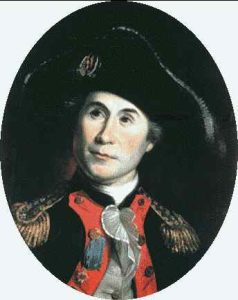Contents

Contents
The Serapis Flag, also known as the Franklin Flag, was one of the first unofficial flags of the United States.
It was created to defuse a diplomatic crisis in 1779, after Captain John Paul Jones captured a British frigate and sailed it to the Dutch port of Texel – potentially saving the captain’s life.
Design and origin
The Serapis Flag features thirteen blue, red and white stripes, arranged horizontally. The canton is the same shade of dark blue, and features thirteen eight-pointed stars, arranged in three horizontal rows of four, five, and four.
The thirteen stars and stripes represent the original Thirteen Colonies of the United States.
In September 1779, during the Battle of Flamborough Head, Navy Captain John Paul Jones captured the HMS Serapis, a British Navy ship. During the battle, his own ship, the Bonhomme Richard, was badly damaged, and quickly sank after his men boarded the Serapis.
Jones captained the frigate to the neutral port of Texel, in North Holland. However, as the fighting was so intense, his own ship’s flag had been blown off, and the Serapis’s ensign had been lost as well.
His ship therefore entered the port with no flag, which was extremely unusual, and for this Jones should have been considered a pirate under maritime law.
John Paul Jones was detained, and officially he should have been hanged. The British were pushing for this, as Jones was a primary target of theirs. His recent attacks on the British coastline had caught their navy by surprise, and embarrassed the country’s leaders.
However, the situation was extremely politically sensitive, especially given it involved a captured British Navy ship. The Dutch Republic wanted to remain neutral in the Revolutionary War, and they wanted an amicable resolution to the situation.
Diplomatic lines of communication were opened with the Americans, and it was decided that a semi-official flag would be created, which Jones and the ship could be recognized under.
According to some historians, Benjamin Franklin, as ambassador to France, was asked to provide a design that could be used.
The previous year, Arthur Lee, another diplomat in France, provided guidelines for an American flag with 13 alternating blue, red and white stripes, and a blue canton with 13 stars. Accordingly, Franklin quickly relayed a design to the Dutch, who created the flag Jones could use, and edited their official records to designate the Serapis Flag as the ensign of the United States.
Usage
Once created, the flag diffused the diplomatic tension, and Jones was released by the Dutch.
The Serapis was too badly damaged for Jones to leave Holland on the ship. Instead, he left on board the USS Alliance, avoiding a British naval blockade on the island. Jones took command of this ship from this point forward, while the Serapis was used by the French Navy.
Apart from a brief period as an ensign of the ship Jones captured, the Serapis Flag’s official usage was short-lived. This was mostly because it had blue stripes instead of just red and white, meaning it did not meet the requirements set out in the Flag Resolution of 1777 passed by the Second Continental Congress. It is still unclear why Franklin’s description of the flag did not meet the guidelines in this resolution – most likely, he was most concerned with communicating a suitable design to the Dutch as soon as possible.
Historical significance
The Serapis Flag was one of the first flags of the United States, although it was never used in an official capacity.
However, the Serapis Flag is strongly associated with John Paul Jones and his heroics as one of the great captains of the Continental Navy, and his contributions to the war effort.
The flag is used to this day on the USS John Paul Jones, a missile destroyer commissioned in 1991, and was featured on a postage stamp in the year 2000.



